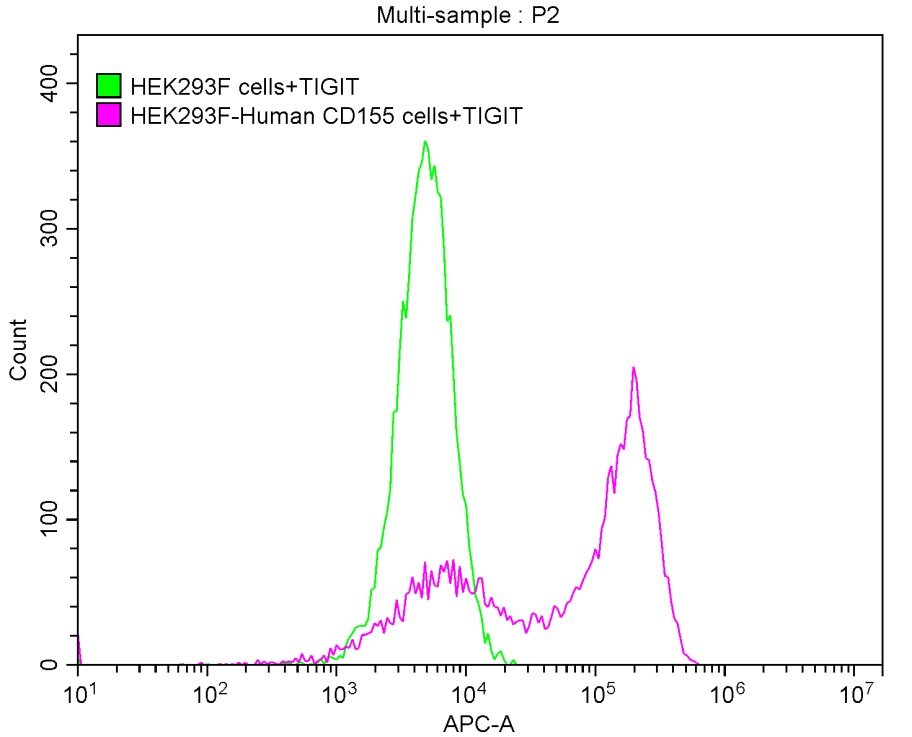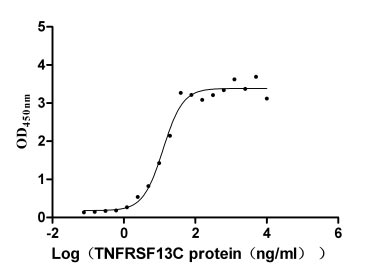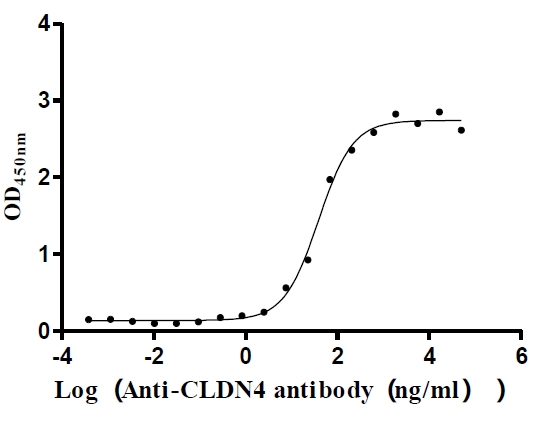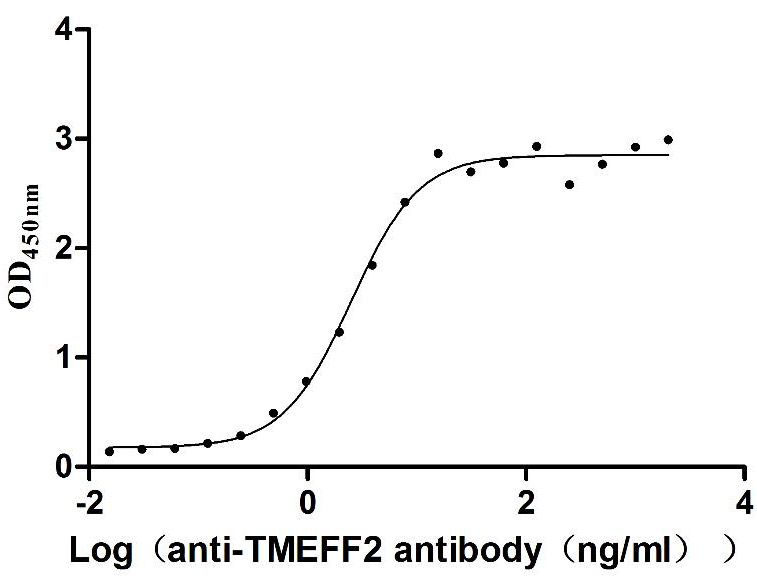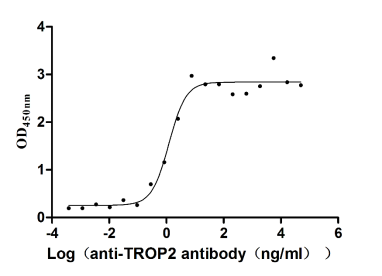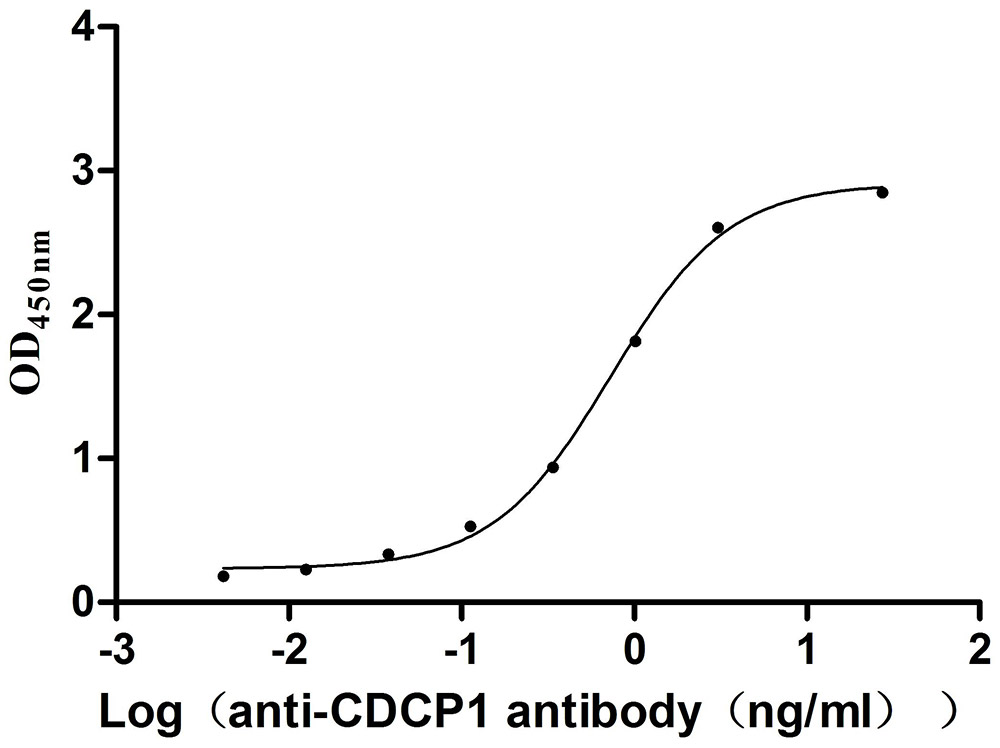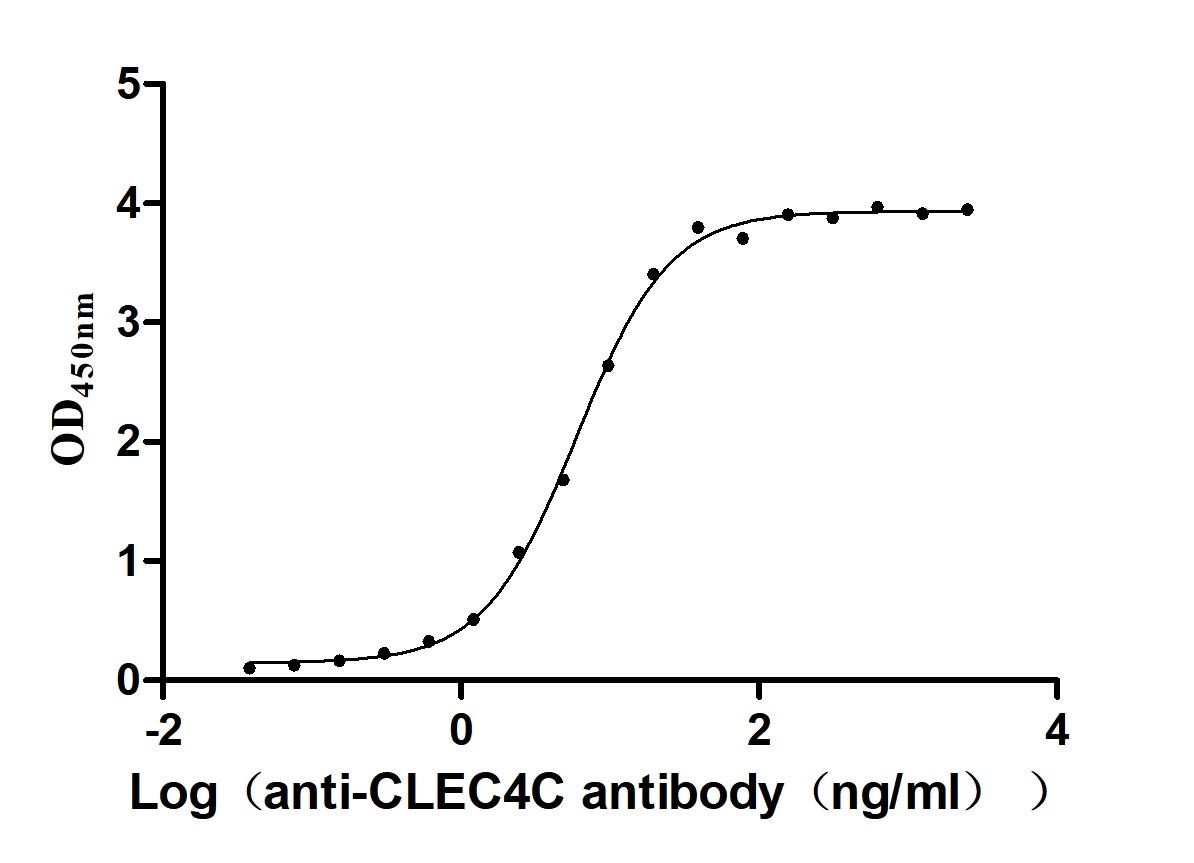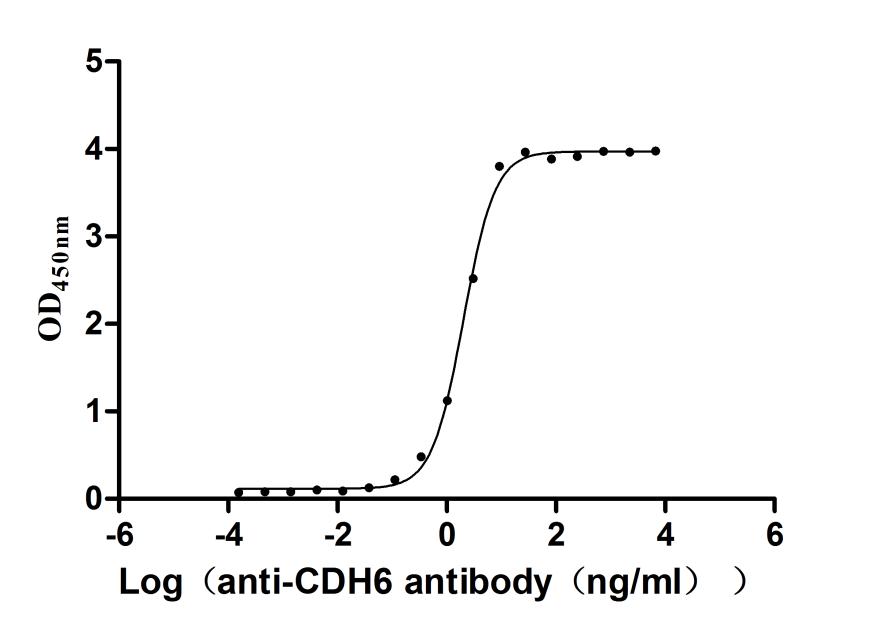Recombinant Human Copper-transporting ATPase 2 (ATP7B), partial
-
货号:CSB-YP002415HU
-
规格:
-
来源:Yeast
-
其他:
-
货号:CSB-EP002415HU-B
-
规格:
-
来源:E.coli
-
共轭:Avi-tag Biotinylated
E. coli biotin ligase (BirA) is highly specific in covalently attaching biotin to the 15 amino acid AviTag peptide. This recombinant protein was biotinylated in vivo by AviTag-BirA technology, which method is BriA catalyzes amide linkage between the biotin and the specific lysine of the AviTag.
-
其他:
-
货号:CSB-BP002415HU
-
规格:
-
来源:Baculovirus
-
其他:
-
货号:CSB-MP002415HU
-
规格:
-
来源:Mammalian cell
-
其他:
产品详情
-
纯度:>85% (SDS-PAGE)
-
基因名:
-
Uniprot No.:
-
别名:ATP7B; ATP7B_HUMAN; ATPase, Cu(2+) transporting, beta polypeptide; ATPase, Cu++ transporting, beta polypeptide; Copper pump 2; Copper transporting ATPase 2; PWD; Toxic milk; tx; WC1; WD; Wilson disease associated protein; Wilson disease-associated protein; WND; WND/140 kDa
-
种属:Homo sapiens (Human)
-
蛋白长度:Partial
-
蛋白标签:Tag type will be determined during the manufacturing process.
The tag type will be determined during production process. If you have specified tag type, please tell us and we will develop the specified tag preferentially. -
产品提供形式:Lyophilized powder
Note: We will preferentially ship the format that we have in stock, however, if you have any special requirement for the format, please remark your requirement when placing the order, we will prepare according to your demand. -
复溶:We recommend that this vial be briefly centrifuged prior to opening to bring the contents to the bottom. Please reconstitute protein in deionized sterile water to a concentration of 0.1-1.0 mg/mL.We recommend to add 5-50% of glycerol (final concentration) and aliquot for long-term storage at -20℃/-80℃. Our default final concentration of glycerol is 50%. Customers could use it as reference.
-
储存条件:Store at -20°C/-80°C upon receipt, aliquoting is necessary for mutiple use. Avoid repeated freeze-thaw cycles.
-
保质期:The shelf life is related to many factors, storage state, buffer ingredients, storage temperature and the stability of the protein itself.
Generally, the shelf life of liquid form is 6 months at -20°C/-80°C. The shelf life of lyophilized form is 12 months at -20°C/-80°C. -
货期:Delivery time may differ from different purchasing way or location, please kindly consult your local distributors for specific delivery time.Note: All of our proteins are default shipped with normal blue ice packs, if you request to ship with dry ice, please communicate with us in advance and extra fees will be charged.
-
注意事项:Repeated freezing and thawing is not recommended. Store working aliquots at 4°C for up to one week.
-
Datasheet :Please contact us to get it.
相关产品
靶点详情
-
功能:Copper ion transmembrane transporter involved in the export of copper out of the cells. It is involved in copper homeostasis in the liver, where it ensures the efflux of copper from hepatocytes into the bile in response to copper overload.
-
基因功能参考文献:
- Study reports the NMR structure of the metal-binding domain 1 (MBD1) of ATP7B. The structure reveals the disruptive mechanism of G85V mutation, one of the very few Singular Wilson disease causing missense mutations in the MBD1-4 region of ATP7B. The protein misfolding will disrupt MBD1-3 interactions, and interfere with proper ATP7B trafficking and activity which, in turn may be followed by protein degradation. PMID: 29330485
- Single-particle analysis yielded a low-resolution 3D model that provides the first insight into an overall architecture of human ATP7B, positions of the main domains, and a dimer interface. PMID: 28842499
- The genotypes of ATP7B gene may be novel and significant biomarkers for predicting the gastrointestinal toxicity of platinum-based chemotherapy in NSCLC patients. PMID: 29970670
- The ATP7B gene codes the ATP7B protein, which is an acronym for: ATPase activity, 7 distinct domain, and B class for second P-type ATPase copper binding pump. PMID: 29540233
- Mutations in the alpha-1-antitrypsin and Wilson's genes may act as cofactors in the pathogenesis of fatty liver diseases. PMID: 29324588
- Compound heterozygous mutations Arg778Leu and a variant in intron4:c.1707 + 5G>A were identified in a case of Wilson's disease with adrenocortical insufficiency. c.1707 + 5G>A variant resulted in exon 4 skipping. PMID: 29181760
- These findings were different from previous studies in Asia. Our research established a suitable strategy for ATP7B gene testing in northern Vietnamese WD patients. PMID: 29321352
- Wilson disease (WD) is an autosomal-recessive disease caused by mutations in the ATP7B gene which encodes a copper-transporting ATPase. PMID: 29325617
- The role of metal-binding domains in ATP7B function and Wilson disease causing point mutations.[review] PMID: 29063292
- for ATP7B mutations, the more severe impact on ATP7B protein was, the younger onset age and lower Cp level presented. The feasibility of presymptomatic DNA diagnosis and predicting clinical manifestation or severity of Wilson disease (WD) would be facilitated with identified mutations and genotype-phenotype correlation precisely revealed in the study. PMID: 27982432
- Among those >800 reported mutations of the ATP7B gene missense/nonsense mutations are very rare. A874V-ATP7B protein mutant showed apparent destabilization and endoplasmic reticulum retention, and lost copper transport activity, thus likely causing Wilson disease phenotype. PMID: 29381936
- Our findings imply that reduced stability and enhanced dynamics of MBD1 or MBD6 is the origin of ATP7B dysfunction in Wilson disease patients with the G85V or G591D mutation. PMID: 27744583
- single nucleotide polymorphisms in ATP7B gene is associated with copper dysmetabolism in Alzheimer's disease. PMID: 27499330
- Mutation in ATP7B gene is associated with copper dysmetabolism in Wilson disease. PMID: 27714068
- We here demonstrate that ATP7B confers multidrug resistance by facilitating nuclear drug efflux and late endosomal drug sequestration. PMID: 26988911
- Wilson's disease results from mutations that cause absent or markedly diminished levels of ATP7B that can be determined in dried blood spots using a novel immune-SRM assay. PMID: 27935710
- Expression of the most frequent ATP7B mutant, H1069Q, activates p38 and c-Jun N-terminal kinase signaling pathways, which favor the rapid degradation of the mutant. PMID: 26660341
- Results reveal that partial gene deletions in ATP7B represent causative mutations in some of the uncharacterized Wilson's disease alleles. PMID: 27992490
- Stratified analysis by genotypes revealed that both outdoor and indoor copper exposure increased inattentiveness in ATP7B rs1061472-CC and rs1801243-CC carriers. PMID: 28008856
- ATP7B mutant cell lines showed different degrees of cell survival and characteristic responses upon treatment with Zn and D-penicillamine. PMID: 27122662
- Five of the nineteen mutations in ATP7B were newly detected mutations; moreover, 8 of these mutations were polymorphic (2 were newly identified). PMID: 27706781
- miR-133a enhances the sensitivity of multidrug-resistant epithelial cells to cisplatin by downregulating ATP7B expression. PMID: 27121102
- the identification of novel mutations in ATP7B for Wilson disease and hereditary hemochromatosis (HFE) or the non-HFE genes for HH has increased, especially with the application of whole genome sequencing technology in recent years, the biological function of the identified mutations, as well as genotype-phenotype correlations remain to be explored PMID: 27592149
- In the group of 75 Wilson Disease patients of Croatian origin, 18 different mutations in ATP7B gene were detected, three of which were novel. The p.His1069Gln mutation was most frequent, being detected in 44 Croatian WD patients (58.7%). Most ATP7B mutations (90.4%) were located in exons 5, 8, 13, 14, and 15. PMID: 26799313
- 24 ATP7B distinct mutations, seven of which are novel, have been found in 35 patients with hepatolenticular degeneration. PMID: 26782526
- With the capability of generating relatively higher throughput in a short time period, the NGS assay is a viable alternative to Sanger sequencing for detecting ATP7B mutations causally linked to Wilson disease in the clinical diagnostic laboratory PMID: 26483271
- analysis of the geographic distribution of ATP7B mutations in Wilson disease [review] PMID: 26207595
- Extrinsic expressing WT ATP7B reduced CuCl2-induced copper accumulation and enhanced cellular copper tolerance by accelerating copper excretion, which was selectively compromised by R778L and P992L mutations. PMID: 26032686
- Metal-dependent movement of the first four metal-binding domains in ATP7B may be a trigger that initiates the overall catalytic cycle. PMID: 26797276
- Nine out of the thirty-two pediatric Turkish WD patients had no mutations in the ATP7B gene. PMID: 26215059
- Novel mutation of the ATP7B gene was found in Chinese families with pre-symptomatic Wilson's disease. PMID: 26253413
- 7 novel mutations, c.3871G>A(p.A1291T), c.2593_2594insGTCA, c.2790_2792delCAT, c.3661_3663delGGG, c.3700delG, c.4094_4097delCTGT, and IVS6+1G>A, are associated with Wilson's disease. PMID: 26829729
- Wilson disease causing p.T788I, p.V1036I and p.R1038G-fsX83 mutations lead to functional deficiency in ATP7B protein. PMID: 26004889
- The present results demonstrate the design and evaluation of a low-density microarray for the detection of 62 mutations in ATP7B gene, and show that a microarray based approach can be cost-effective for detecting a large number of mutations simultaneously PMID: 25900953
- Screening for the two exons 14 and 18 of the ATP7B gene is important in Egyptian patients especially in suspected patients without hepatic manifestations. PMID: 25465132
- The ATP7B gene testing for the boy, his sister, and their parents detected two novel missense mutations in the boy and his sister, i.e., compound heterozygous mutations in exon 7 and exon 13 PMID: 26182283
- Most frequent mutation c.3402delC (p.Ala1135GlnfsX13) among Wilson disease patients in Venezuela has a wide distribution and two old origins PMID: 25497208
- The detection of new mutations in the ATP7B gene can aid in genetic counseling and clinical or/prenatal diagnosis. PMID: 25982861
- Identification of mutations and polymorphisms of the ATP7B gene which may contribute to the pathogenesis of Wilson disease. PMID: 24878384
- association between the c.2299insC mutation and hepatic phenotype and between the p. Ala1003Thr mutation and neurologic phenotype in Wilson disease in a large Lebanese family PMID: 25390358
- The purpose of this study was to determine a haplotype analysis of two unrelated Wilson disease patients with the same missense mutation PMID: 25365615
- showed that hyperphosphorylation occurs even when ATP7B is restricted to the trans-Golgi network PMID: 25666620
- Wilson disease patients with the splice-site mutation show severe clinical manifestations, indicating that aberrant transcripts have important implications for Wilson disease phenotype. PMID: 25086856
- Study identifies three novel mutations in ATP7B, confirms Arg778Leu as the most frequent mutation in Chinese Wilson's disease (WD) patients, and demonstrates that Ile1148Thr was another hotspot mutation in WD patients from Southern China PMID: 25089800
- Data show that nanobodies detected transient interactions between the metal-binding domains (MBDs) and modulated intracellular localization of Cu(I)-ATPase ATP7B. PMID: 25253690
- The functional survey of amino acid changes in the ATP7B protein is provided herein, and this bioinformatic method can furnish information about novel ATP7B mutations. Furthermore, the same approach can be applied to other uncharacterized proteins. PMID: 24253677
- ATP7B gene might be considered as predictive markers for the efficacy evaluation of platinum-based chemotherapy in Chinese Han lung cancer patients PMID: 24852429
- different coding mutations were detected in our patient pool including 21 novel and 37 reported variants in Indian patients with Wilson disease PMID: 24094725
- revealed an unexpected role for TM1/TM2 in copper-regulated trafficking of ATP7B and defined a unique class of WD mutants that are transport-competent but trafficking-defective PMID: 24706876
- Individuals who were GG homozygous for ATP7B rs7323774 SNP had higher levels of serum-free copper, and this condition was more pronounced in the AD individuals. PMID: 23760784
显示更多
收起更多
-
相关疾病:Wilson disease (WD)
-
亚细胞定位:Golgi apparatus, trans-Golgi network membrane; Multi-pass membrane protein. Late endosome.; [Isoform 1]: Golgi apparatus membrane; Multi-pass membrane protein.; [Isoform 2]: Cytoplasm.; [WND/140 kDa]: Mitochondrion.
-
蛋白家族:Cation transport ATPase (P-type) (TC 3.A.3) family, Type IB subfamily
-
组织特异性:Most abundant in liver and kidney and also found in brain. Isoform 2 is expressed in brain but not in liver. The cleaved form WND/140 kDa is found in liver cell lines and other tissues.
-
数据库链接:
HGNC: 870
OMIM: 277900
KEGG: hsa:540
STRING: 9606.ENSP00000242839
UniGene: Hs.492280
Most popular with customers
-
Recombinant Human T-cell immunoreceptor with Ig and ITIM domains (TIGIT), partial (Active)
Express system: Mammalian cell
Species: Homo sapiens (Human)
-
Express system: Mammalian cell
Species: Homo sapiens (Human)
-
Recombinant Human Claudin-4 (CLDN4)-VLPs (Active)
Express system: Mammalian cell
Species: Homo sapiens (Human)
-
Recombinant Human Tomoregulin-2 (TMEFF2), partial (Active)
Express system: Mammalian cell
Species: Homo sapiens (Human)
-
Recombinant Human Tumor-associated calcium signal transducer 2 (TACSTD2), partial (Active)
Express system: Mammalian cell
Species: Homo sapiens (Human)
-
Recombinant Mouse CUB domain-containing protein 1 (Cdcp1), partial (Active)
Express system: Mammalian cell
Species: Mus musculus (Mouse)
-
Recombinant Macaca fascicularis C-type lectin domain family 4 member C(CLEC4C), partial (Active)
Express system: Mammalian cell
Species: Macaca fascicularis (Crab-eating macaque) (Cynomolgus monkey)
-
Recombinant Mouse Cadherin-6(Cdh6),partial (Active)
Express system: Mammalian cell
Species: Mus musculus (Mouse)


